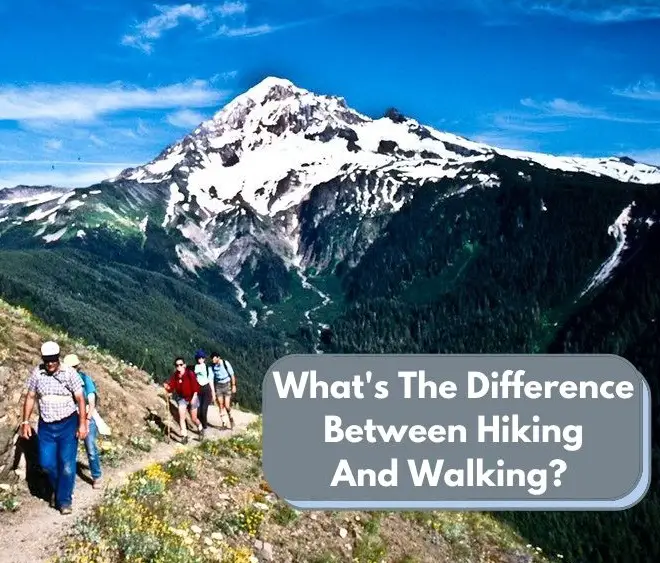As hiking’s popularity continues to rise as an outdoor activity for all ages and most fitness levels, many people new to hiking often ask: what’s the difference between hiking and walking? Hiking is done exclusively outdoors on mostly unpaved hiking trails with the goal of immersing the participant in nature, and usually includes inclines and declines on the hiking terrain. Walking is a leisurely activity done mostly on paved surfaces like sidewalks or paths, and can be done both indoors and outdoors.
As the saying goes: every hiker walks, but not every walker hikes!
Let’s explore more of the differences between walking and hiking below.
| Walking | Hiking | |
| Surface | Paved, Flat Surface Indoor/Outdoor Or Treadmill | Natural Hiking Trails |
| Environment | Anywhere | Natural Outdoor Areas (Parks, Forests, Wilderness) |
| Gear | Walking Shoes | Hiking Boots, Backpack, Trekking Poles, Possibly Survival Gear |
| Frequency | Anytime | Sometimes Limited By Season Or Weather Conditions |
| Calories Burned Per Hour | 100 Calories per Hour | 250+ Calories per Hour |

What’s The Difference Between Hiking And Walking?
Hiking Is Outdoors Only
While walking can be done indoors or outdoors on a variety of surfaces, hiking is an outdoor-only activity performed on hiking trails.
Walking Paths Vs Hiking Paths
Although there are some paved hiking paths found in parks or conservation areas, the majority of hiking trails are natural worn paths that follow the earth’s terrain, featuring inclines and declines and possible water crossings like creeks or streams.
Hiking Has A Destination In Mind
Of course people walk to move their bodies from one point to another, but walking for exercise usually involves a path or circular trail which may be traveled several times.
Hiking trails usually have a destination point on them such as a ridgeline, peak, summit, or waterfall that offers a breathtaking view, serving as a huge payoff for all the hard work of hiking to that point.
Walking Vs Hiking: Energy Expenditure
Hiking requires more energy than walking because of the inclines, declines, and natural obstacles featured on hiking trails.
When hiking you’ll typically be out on the trail for longer than most walks, so you’ll also be carrying a hiking backpack or daypack which will have your gear.
Hauling this pack and the extra weight associated with it will also require more energy than just walking with a water bottle and your smartphone in hand.
Calories Burned Walking Vs Hiking
Hiking burns about 2.5 times more calories per hour than walking does.
For example, walking burns about 100 calories per hour while hiking burns over 250 calories per hour.
Fitness Requirements Of Walking Vs Hiking
While walking is a great activity to stay fit and active for nearly everyone, hiking works more muscles due to the inclines and declines and rough terrain found on natural hiking paths.
As such, walking has a lower fitness threshold than hiking does – nearly anyone can begin walking any distance and build up longer distances over time.
Fortunately, hiking is very approachable to most age groups and skill levels as well – it just takes that same building-up period to work your way to longer and more fulfilling hikes.
Check out these helpful hiking fitness guides to get your body ready for hiking:
Exercises To Give You Explosive Power For Hiking Uphill
How To Strengthen And Prepare Your Knees For Hiking
How To Prepare Your Feet For Hiking

What’s The Difference Between Hiking And Walking Gear?
The main difference between gear needed for walking and hiking is the footwear you’ll need, as most walking trails are flat and paved and most hiking trails are not.
The uneven terrain and slopes on hiking trails demands more support and traction found in proper hiking footwear, so it’s important that you don’t hit the trail in an old pair of sneakers that won’t properly protect you and your feet.
We’ve put together some great picks on the best men’s hiking boots for under $100 and the best women’s hiking boots for under $100 so you can get started, and if you decide to grab some new hiking boots, check out our guide to how hiking boots should fit while you’re at it..
Gear Needed For Walking
- Walking Shoes
- Water
- Sunscreen (optional)
- Snacks (optional)
Gear Needed For Hiking
- Hiking Boots
- Hiking Socks
- Daypack Or Hiking Backpack
- First Aid Kit
- Sunscreen
- Snacks
- Water (see our guide on the best way to carry water while hiking for tips)
- Hiking Knife
- Weather-Appropriate Hiking Clothes (check out our guide to what to wear hiking in fall for example)
The Benefits Of Walking Vs Hiking
Walking can be done anywhere (even on a treadmill at home), requires little to no equipment or preparation, and is generally safer than hiking.
Hiking gets you fully immersed in nature, with plenty of flora, fauna, and animals to see. It also offers better exercise by burning more than 2.5 times the amount of calories than walking does.
Both forms of exercise are good for getting and staying fit (hiking even burns belly fat), but hiking and spending time outdoors has been shown to have additional mental benefits like reduced stress, lowered anxiety, and lowered risk of depression.
Although hiking is not a sport, it’s an excellent hobby that you can expand upon much greater than walking.

9 Key Differences Between Walking And Hiking
It’s A Walk If:
- The trail is paved
- The trail is short (2 miles or less)
- The trail is mostly level
- The trail takes an hour or less to complete round-trip
It’s A Hike If:
- The trail is unpaved
- The terrain is rough and includes inclines and declines
- The trip takes a few hours or longer to complete round-trip
- You have to use a good bit of energy to complete the journey
- You need to prepare by bringing supplies and snacks

Wrapping Up The Differences Between Hiking And Walking
While both hiking and walking are good forms of healthy exercise for most age groups and skill levels, they do have their differences.
Walking can be done anywhere for nearly any amount of time and with less gear and preparation.
Hiking is outdoor only, requires more gear and preparation, and has more physical and mental benefits than walking provides.

